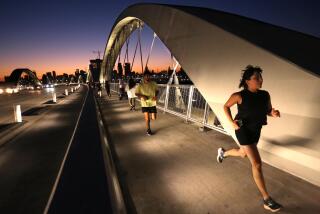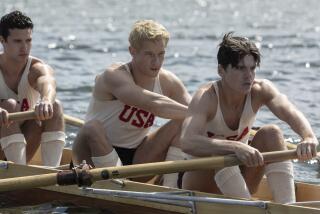The Scull and Bones Society
- Share via
It’s as if a piece of the Charles River had been grafted onto the sea lanes behind the Marina del Rey breakwater. On any given morning, usually before dawn, the salt-sprayed air is punctuated by a coxswain’s vigorous Hut! Hut! Hut! and the rhythmic slap of synchronized rowing. Hours before the marina’s pleasure-craft crowd spills its first latte, sculling teams-four rowers per boat plus a coxswain--are racing at breakneck speed, their faces contorted in earnest concentration.
“It’s like their health club,” explains Buz Tarlow, 39-year-old president and head coach of the Southern California Boat Club, puttering comfortably behind his teams in a motorized launch. The beefy onetime Harvard sculling coach has been training Southern Californians in this Ivy League art for four years, in addition to his club’s less-rarefied disciplines of sailing, canoeing and kayaking.
Though sculling’s tweedy anti-fashion hews to the Westside’s fetish for Range Rover/natural-fiber faux-naivete, the draw among Tarlow’s charges is forthright: sculling can burn as many as 1,600 calories an hour while strengthening the heart, legs, back, shoulders, stomach and arms. What’s more, Tarlow notes, in between yelling instructions to the racing rowers just off his bow, “the energy, discipline and the focus they learn here makes them successful everywhere they go.”
Indeed, such is the dedication to the art of the row that scullers are not only undaunted by the 5:30 a.m. workout time, but often show up despite feeling under the already blustery weather.
“I’m afraid to know whether I have a temperature or not,” frets attorney Tracy Smith, barely croaking out the words. Today’s coxswain, Smith wouldn’t hear of missing her workout despite her fragile health. “It’s better than having the boat go out without me,” she declares.
This is the mellow time of the season. During the April-to-December racing circuit, the scullers travel from Lake Tahoe to San Diego, taking on the college kids and the boat clubs.
“We have a little bit of time off now,” says Henry Arnsten, a 35-year-old medical researcher and member of the men’s rowing team, who’s putting in an off-peak three to four days a week. Come April, they’ll be doing it daily. Why such dedication?
“It’s the feeling you get from being in the water and doing something no one understands,” he says mystically, then adds: “Not to mention there are four other people waiting down here who will break your neck if you don’t show up.”


